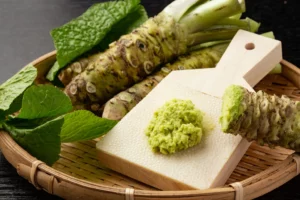What Is Wasabi, the Signature Japanese Restaurant Spice?

If you’re a fan of sushi and sashimi, you’re probably familiar with wasabi. In Japanese restaurants, especially those serving sushi and sashimi, you often encounter a small dish filled with a green paste that resembles matcha. Sometimes, these food is directly added to the serving plates of sushi and sashimi.
Although it may not look spicy like chili due to its green color, it has a strong flavor that hits your nose. However, enjoying sushi or sashimi just isn’t the same without this condiment. So, what exactly is wasabi? What are its benefits, and is it halal? Let’s dive into the answers here.

The Origins of Wasabi
Wasabi is a spicy condiment that originates from Japan. It’s made from the wasabi plant, a member of the Brassicaceae family, which includes cabbage and mustard. The preparation involves grating the stem, resulting in a thick, paste-like substance.
These food typically thrives in mountainous regions with cold temperatures, such as Japan, Korea, and China. This means that it isn’t exclusive to Japan alone.
Historically, these food has been considered a special food and a traditional remedy, often used by the ruling class during the Jomon period in Japan (14,000 BC – 400 BC). Back in the day, wasabi was quite expensive due to its scarcity and short shelf life.
For a long time, it has served as a condiment for sushi and sashimi. Traditional Japanese medicine has also employed for centuries, using it to treat various ailments like toothaches, stomachaches, and diarrhea. The Japanese have even studied the various health benefits, particularly its antibacterial, anti-inflammatory, and antioxidant properties.
Health Benefits of Wasabi
Beyond being a culinary spice, wasabi offers several health benefits. Here are some of the advantages of consuming it:
Fighting Bacteria Wasabi can help combat the growth of bacteria in the mouth and digestive system. The isothiocyanates compounds have antibacterial properties. These compounds help kill bacteria responsible for diseases such as Staphylococcus aureus and Escherichia coli. That’s why it is consumed with sushi and sashimi to prevent food poisoning.
Reducing Inflammation Wasabi can reduce inflammation in joints, muscles, and organs. There’s a compound called sinigrin that aids in reducing inflammation. This compound helps alleviate pain and swelling caused by inflammation.
Improving Heart Health Wasabi can enhance heart health by lowering cholesterol and triglyceride levels in the blood. It has anti-hypercholesterolemic properties, which play a role in reducing cholesterol and triglyceride levels when consumed. As a result, the risk of heart diseases can be reduced.
Enhancing Brain Function Wasabi helps protect the brain from damage caused by free radicals. With its antioxidant compounds, can safeguard brain cells from free radical-induced damage.
Maintaining Digestive Health The isothiocyanate compounds in wasabi have been shown to fight H. pylori bacteria, which can cause infections in the small intestine and stomach. Consuming it can help maintain the digestive health of the body.
How to Enjoy
Wasabi is often considered a condiment because of its sharp and pungent flavor. However, its spiciness is different from chili, which provides a tongue-tingling sensation. Its fiery sensation can be felt in the nose, which might be uncomfortable for some.
The antimicrobial isothiocyanate compounds contribute to the pungent sensation and tingling taste. Properly enjoying it involves placing it directly on the meat. This creates a perfect sensation with the contrast of fresh, sweet fish and the sharp wasabi that explodes in your mouth while also hitting your nose. It’s a unique sensation that can be addictive!
Wasabi is also used as an extra condiment for soba, ramen, or udon. The savory broth of these dishes gets a spicy and refreshing touch from wasabi. It’s sure to increase your appetite and have you slurping up every last drop.
Additionally, wasabi is often used as a flavor variant for specific foods and beverages, such as chips, nuts, seaweed, and even ice cream.
The key is to use wasabi sparingly, as even a small amount can provide an intense spiciness. This way, you can still enjoy the authentic taste of sushi and sashimi through the contrasting combination that creates a unique harmony of flavors in every bite. So, are you on team wasabi when it comes to sushi or sashimi?




